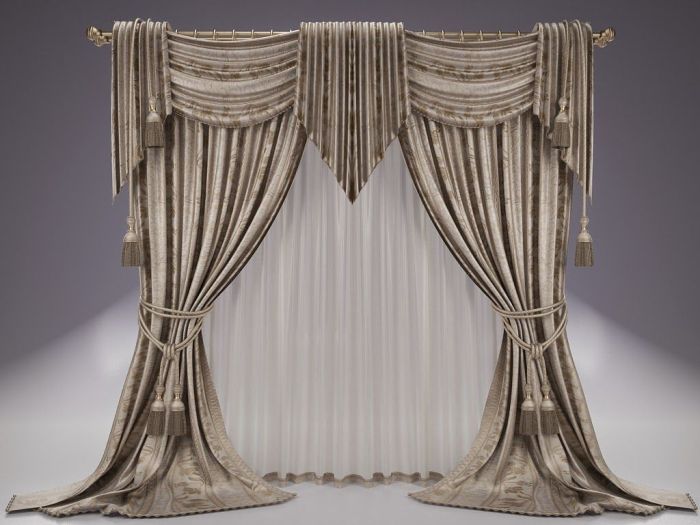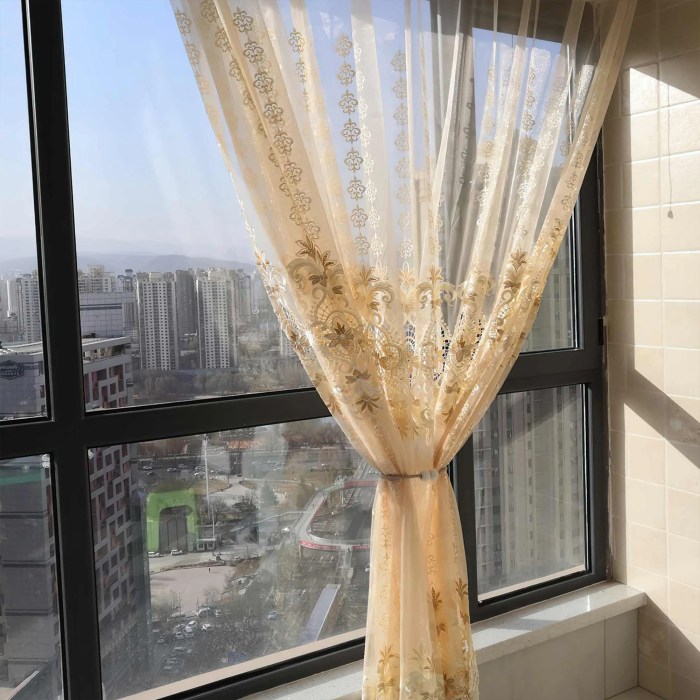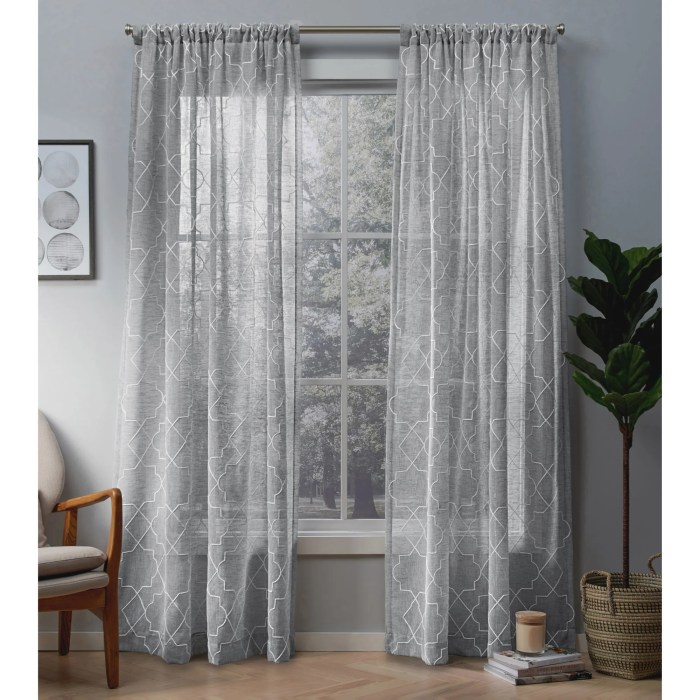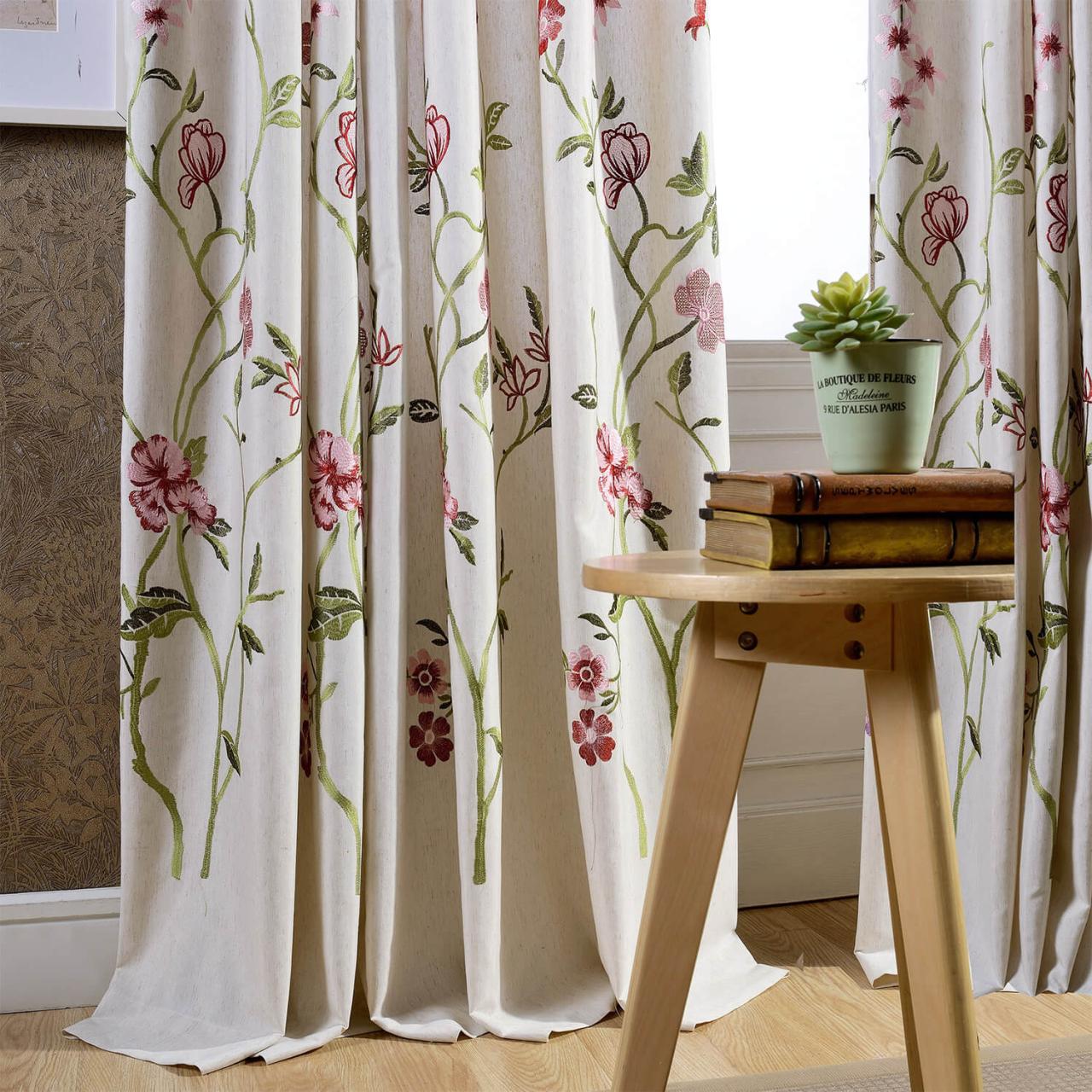The enduring appeal of classic interior design finds a perfect complement in the artistry of embroidered curtains. These aren’t merely window treatments; they are intricate works of textile art, adding layers of texture, color, and historical resonance to a space. From the delicate floral motifs of a Victorian parlor to the bold geometric patterns of a modern interpretation of Georgian style, embroidered curtains offer a unique opportunity to personalize and elevate classic décor.
This exploration delves into the rich tapestry of design, manufacturing, and stylistic integration that makes these curtains a cornerstone of timeless elegance.
The market for embroidered curtains within the classic decor sphere is experiencing a resurgence, driven by a growing appreciation for handcrafted details and a desire for personalized spaces. This renewed interest reflects a shift away from mass-produced, generic designs towards bespoke pieces that reflect individual style and a commitment to quality. The characteristics defining “classic decor” – often associated with rich fabrics, symmetrical layouts, and a focus on craftsmanship – are beautifully mirrored in the intricate detail and varied textures offered by embroidered curtains.
When compared to other window treatments, embroidered curtains offer a distinct advantage in their ability to blend seamlessly with existing décor while simultaneously adding a touch of unique personality. Different embroidery styles, from delicate floral patterns to more structured geometric designs, cater to a wide spectrum of tastes and aesthetic preferences within the classic decor realm.
Market Overview: Embroidered Curtains in Classic Decor
The market for embroidered curtains, particularly within the classic decor segment, demonstrates a steady and consistent demand. This reflects a broader trend towards personalized and high-quality home furnishings, with consumers increasingly valuing craftsmanship and unique design elements. Classic decor, with its emphasis on timeless elegance and enduring style, provides a perfect canvas for the intricate artistry of embroidered curtains.The enduring appeal of embroidered curtains in classic interiors stems from their ability to blend seamlessly with traditional architectural features and furniture styles.
Classic decor is typically characterized by symmetrical layouts, rich color palettes often incorporating jewel tones and muted earth tones, and the use of high-quality, natural materials such as linen, silk, and cotton. Curtains in this context serve not only as window treatments but also as integral components of the overall aesthetic, adding texture, pattern, and a touch of opulence.
Comparison of Embroidered Curtains with Other Window Treatments in Classic Settings
Embroidered curtains offer a distinct advantage over other window treatment options within classic decor settings due to their versatility and ability to enhance the overall ambiance. While blinds and shutters provide functionality, they often lack the softness and visual interest of embroidered curtains. Similarly, plain drapes, although versatile, may appear less sophisticated compared to the intricate detail and personalized touch provided by embroidery.
The luxurious texture and handcrafted quality of embroidered curtains elevate the overall look, contributing significantly to the feeling of timeless elegance that defines classic interior design. This contrasts with the potentially more modern and minimalist feel of other options like roller blinds or cellular shades.
Embroidery Styles Suitable for Classic Decor
The choice of embroidery style significantly impacts the overall aesthetic of the curtains within a classic decor scheme. Different styles evoke distinct moods and complement various design elements.
| Style Name | Thread Type | Color Palettes | Typical Fabric |
|---|---|---|---|
| Floral Damask | Silk, Rayon | Deep reds, golds, greens, ivory | Linen, Silk |
| Geometric Medallion | Cotton, Linen | Muted blues, greens, creams | Linen, Cotton Blend |
| Paisley | Silk, Metallic Threads | Rich jewel tones, muted pastels | Velvet, Brocade |
| Classical Scrollwork | Cotton, Embroidery floss | Creams, beige, browns | Cotton, Linen |
Design Elements & Aesthetics

The aesthetic appeal of embroidered curtains in classic decor hinges on a careful interplay of color palettes, fabric textures, and design patterns. These elements work in concert to create a specific mood and visual impact, reflecting the timeless elegance associated with classic interior design. Understanding the principles behind these choices is crucial for achieving a cohesive and sophisticated look.
Color palettes in classic decor often favor a restrained and harmonious approach. Muted tones, such as soft blues, greens, creams, and greys, create a sense of calm and sophistication. The use of analogous colors – those adjacent to each other on the color wheel – fosters a sense of unity and tranquility. Conversely, the strategic use of accent colors, such as a deep jewel tone or a vibrant floral hue, can add a touch of drama and visual interest without disrupting the overall sense of balance.
The choice of color should always consider the existing color scheme of the room and the desired level of contrast.
Color Palettes in Classic Decor
The selection of colors significantly influences the overall atmosphere. A living room might benefit from a palette of muted greens and creams, perhaps with a touch of gold embroidery to add richness. A bedroom might utilize softer blues and lavenders, promoting relaxation. A dining room, on the other hand, might employ warmer tones like terracotta or deep reds, stimulating conversation and creating a welcoming ambiance.
The principle of color psychology plays a vital role; for instance, cool colors are known to evoke calmness, while warm colors tend to stimulate energy and appetite.
Impact of Fabric Textures
The choice of fabric significantly impacts the visual and tactile experience of the embroidered curtains. Linen, with its natural texture and slightly uneven weave, offers a rustic charm and lends itself well to more informal classic styles. Silk, with its luxurious sheen and smooth drape, creates a feeling of opulence and sophistication, ideal for formal settings. Cotton, a versatile and durable option, provides a balance between luxury and practicality, making it suitable for various classic styles.
The weight and drape of the fabric also affect the overall aesthetic; heavier fabrics create a more substantial and formal look, while lighter fabrics offer a more airy and delicate feel.
Classic Design Patterns for Embroidery
Classic design patterns suitable for embroidered curtains often draw inspiration from nature and historical motifs. Floral patterns, such as trailing roses, delicate blossoms, or stylized leaves, remain timeless choices. Geometric patterns, including stripes, damasks, and paisleys, offer a more structured and formal look. Other suitable patterns include arabesques, which feature intricate flowing lines, and Chinoiserie patterns, inspired by Chinese art.
The scale and density of the pattern should be considered in relation to the size of the window and the overall design of the room.
Embroidered Curtain Designs for Classic Rooms
The following examples illustrate how embroidery style, fabric choice, and color scheme can be tailored to different rooms within a classic home.
- Living Room: A cream linen curtain with a large-scale embroidered floral pattern featuring trailing roses in shades of blush pink and soft green. The embroidery style is a raised satin stitch, adding texture and dimension. This design creates a sense of relaxed elegance.
- Bedroom: A pale blue silk curtain with a delicate embroidered pattern of stylized leaves and blossoms in shades of lavender and silver. The embroidery style is a fine seed stitch, creating a subtle yet elegant texture. This design promotes a calm and restful atmosphere.
- Dining Room: A deep red cotton curtain with a bold embroidered damask pattern in gold thread. The embroidery style is a combination of satin stitch and French knots, creating a rich and luxurious effect. This design adds a touch of formality and sophistication.
Manufacturing & Materials

The creation of embroidered curtains for classic decor involves a complex interplay of artistic skill, material science, and manufacturing processes. The final product’s quality, durability, and aesthetic appeal are directly influenced by the choices made at each stage, from fabric selection to the embroidery technique employed. Understanding these factors is crucial for both manufacturers and consumers seeking high-quality, long-lasting embroidered curtains.
Embroidered curtains represent a confluence of textile engineering and artistic expression. The choice of embroidery technique significantly impacts the final product’s texture, detail, and overall visual impact, while the fabric’s properties determine its drape, longevity, and ease of maintenance. Sustainable sourcing practices further enhance the ethical and environmental credentials of these classic home furnishings.
Embroidery Techniques in Curtain Production
Several embroidery techniques are suitable for curtain production, each offering unique aesthetic and functional characteristics. Machine embroidery allows for high-speed production of intricate designs, while hand embroidery offers unparalleled detail and artistic control. Different techniques lend themselves to different fabric types and design complexities.
For instance, chain stitch, a simple yet effective technique, is often used for large-scale designs or outlining motifs on heavier fabrics. Satin stitch, known for its smooth, lustrous surface, is ideal for creating solid blocks of color or filling in intricate designs. More complex techniques, like French knots or seed stitch, add texture and visual interest, particularly effective in creating floral or botanical patterns.
Fabric Durability and Maintenance
The durability and maintenance requirements of embroidered curtains are largely determined by the fabric used. Linen, a natural fiber known for its strength and breathability, is relatively durable but requires careful cleaning to prevent shrinkage or damage. Cotton, another popular choice, is softer than linen and easier to care for, though it may wrinkle more easily. Polyester blends offer increased durability and wrinkle resistance, making them a practical choice for high-traffic areas.
Silk, while luxurious, is more delicate and requires specialized cleaning.
The embroidery itself can also affect the fabric’s durability. Heavily embroidered curtains may be more prone to wear and tear in high-stress areas. The type of thread used also plays a role; high-quality, colorfast threads are essential for maintaining the curtain’s appearance over time. Regular vacuuming and gentle cleaning are recommended for all embroidered curtains, with specific care instructions varying depending on the fabric composition.
Sourcing and Sustainability of Materials
The sourcing and sustainability of materials are increasingly important considerations in the production of embroidered curtains. Ethically sourced cotton, linen, and silk, certified by organizations like the Global Organic Textile Standard (GOTS), ensure that the materials are produced with minimal environmental impact and fair labor practices. Recycled polyester fibers offer a more sustainable alternative to virgin polyester, reducing reliance on petroleum-based resources.
Furthermore, responsible dyeing practices, utilizing low-impact dyes and minimizing water consumption, contribute to a more environmentally friendly manufacturing process.
Transparency in the supply chain is also crucial. Consumers are increasingly demanding information about the origin and production methods of the materials used in their home furnishings. Brands that provide clear and detailed information about their sourcing practices are more likely to appeal to environmentally and socially conscious consumers. Choosing curtains made with sustainably sourced materials not only benefits the environment but also supports ethical and responsible manufacturing practices.
Manufacturing Process of Embroidered Curtains
The manufacturing process of embroidered curtains involves a series of precise steps, ensuring a high-quality final product. The entire process, from design conception to final finishing, requires meticulous attention to detail.
- Design and Pattern Creation: The process begins with the design of the embroidery pattern, often using specialized software. This stage involves selecting the appropriate embroidery technique, stitch density, and thread colors.
- Fabric Selection and Cutting: Appropriate fabric is selected based on desired drape, durability, and maintenance requirements. The fabric is then cut to the specified dimensions for the curtains.
- Embroidery: The chosen embroidery technique is applied to the fabric using either machine or hand embroidery methods. This stage requires precise control to ensure the accuracy and consistency of the design.
- Sewing and Finishing: Once embroidered, the fabric panels are sewn together to create the finished curtains. This includes adding hems, pleats, and any other desired finishing details.
- Quality Control: A rigorous quality control process ensures that the finished curtains meet the required standards of quality, including checking for any defects in the embroidery or stitching.
- Packaging and Distribution: Finally, the curtains are packaged and prepared for distribution to retailers or directly to consumers.
Styling & Integration with Classic Decor
Embroidered curtains, with their inherent richness and texture, offer a versatile approach to complementing various classic interior design styles. Their ability to soften harsh lines, add warmth, and introduce a touch of elegance makes them a prized element in achieving a truly classic aesthetic. The strategic integration of these curtains involves careful consideration of style, scale, and the use of complementary accessories.
The interplay between curtain style, fabric choice, and embroidery design dictates the overall impact on the room’s ambiance. For instance, heavier fabrics with intricate embroidery patterns are ideal for creating a sense of grandeur, while lighter fabrics with simpler designs offer a more delicate and airy feel. Understanding these nuances is crucial in harmoniously integrating embroidered curtains into a classic interior.
Embroidered Curtain Styles for Classic Interior Design
The selection of embroidered curtains should align with the specific classic style being emulated. Victorian interiors, known for their opulent and layered aesthetic, benefit from heavy velvet or damask curtains with rich, detailed embroidery, perhaps featuring floral motifs or scenes from nature. Georgian style, characterized by its symmetry and understated elegance, is well-served by linen or silk curtains with more subtle embroidery, perhaps featuring geometric patterns or repeating motifs.
French Provincial style, with its rustic charm and romantic flourishes, would complement beautifully with lighter cotton or linen curtains featuring delicate floral embroidery or toile patterns. The choice of embroidery design and fabric weight directly impacts the overall feeling of the room. A room designed in a Victorian style, for example, might feature deep crimson velvet curtains with gold thread embroidery depicting lush floral arrangements, while a French Provincial room might use pale yellow linen curtains with a delicate embroidered lavender pattern.
Determining Appropriate Curtain Lengths and Widths
Properly sized curtains are essential for achieving a polished look. For floor-length curtains, a general guideline is to allow the fabric to fall approximately 1-2 inches from the floor. This prevents the curtains from dragging and getting soiled. The width should be at least 1.5 to 2 times the width of the window to allow for ample fullness and drapery.
For windows that are particularly wide, consider using multiple panels to ensure proper coverage and a more balanced aesthetic. In smaller rooms, using curtains that extend slightly beyond the window frame can create an illusion of greater space. Conversely, in larger rooms, wider panels can enhance the sense of scale and grandeur. Careful consideration of the window size and the room’s dimensions is critical in determining the appropriate curtain length and width.
Layering and Accessories for Enhanced Visual Appeal
Layering and accessories significantly contribute to the overall impact of embroidered curtains within a classic setting. Tiebacks, for instance, can be used to elegantly hold back the curtains during the day, revealing the window and allowing natural light to enter. They can be made from coordinating fabrics or feature decorative elements that complement the embroidery on the curtains.
Valances, which are decorative fabric panels placed at the top of the window, can add a layer of sophistication and visual interest, further enhancing the classic aesthetic. The combination of layered curtains with contrasting textures and colors, along with carefully selected tiebacks and valances, can transform a simple window into a stunning focal point.
Visual Description of a Classic Bedroom with Embroidered Curtains
Imagine a serene bedroom designed in a Georgian style. The walls are painted a soft, muted green, complemented by white crown molding and baseboards. The furniture is made of dark, polished mahogany, featuring a four-poster bed with a tufted headboard and a matching dresser and nightstands. The embroidered curtains, crafted from a luxurious cream-colored linen, hang from elegant brass rods.
The embroidery itself is a delicate repeating pattern of small, stylized floral motifs in muted shades of blue and green, subtly echoing the wall color. The curtains are floor-length, falling gracefully to the carpet, creating a sense of calm and sophistication. Simple, understated tiebacks in a matching linen fabric hold the curtains back during the day, revealing a window adorned with a simple white lace panel.
The overall effect is one of refined elegance and understated luxury, where the embroidered curtains serve as a perfect complement to the room’s classic style and color palette.
Care & Maintenance

Preserving the beauty and longevity of embroidered curtains requires a thoughtful approach to cleaning and maintenance. The delicate nature of embroidery, combined with the varied fabric compositions commonly used in classic decor, necessitates a careful consideration of cleaning methods and potential problems. Understanding the specific needs of your curtains will ensure their beauty endures for years to come.The choice of cleaning method hinges critically on the fabric composition of your embroidered curtains.
Natural fibers like linen and cotton often react differently to cleaning agents than synthetic materials such as polyester or silk blends. Ignoring these differences can lead to irreversible damage, including shrinking, color fading, or damage to the embroidery itself. Therefore, understanding your fabric is the first step in successful care.
Cleaning Methods Based on Fabric Type
Choosing the appropriate cleaning method is paramount to preserving the integrity of your embroidered curtains. Incorrect cleaning can lead to shrinkage, discoloration, or damage to the delicate embroidery. The following guidelines provide a framework for selecting the best approach:
- Linen and Cotton Curtains: These natural fibers are generally durable and can often withstand hand washing in cool water with a mild detergent. Always test a small, inconspicuous area first to check for colorfastness. Avoid harsh scrubbing or wringing, and gently press excess water out before air drying flat. Machine washing is generally discouraged, as it can lead to shrinkage and damage to the embroidery.
- Silk and Delicate Fabrics: Curtains made from silk or other delicate fabrics require professional dry cleaning. The solvents used in dry cleaning are specifically designed to clean delicate materials without causing damage. Attempting to clean these materials at home could result in irreversible damage to the fabric and embroidery.
- Polyester and Synthetic Blends: These fabrics are generally more resilient and can often tolerate machine washing on a gentle cycle with cold water and a mild detergent. However, always check the care label for specific instructions and consider using a mesh laundry bag to protect the embroidery. Air drying is preferred to prevent shrinkage and damage.
Common Issues and Solutions
Despite careful handling, certain issues may arise with embroidered curtains. Proactive measures and prompt solutions can minimize the impact of these problems.
- Fading: Exposure to direct sunlight can cause fading. Using curtains with UV-resistant lining or minimizing direct sunlight exposure can help prevent this. Regular cleaning can also help remove dust and grime that can contribute to fading.
- Shrinkage: Incorrect washing methods, particularly machine washing without checking care instructions, can cause shrinkage. Always follow the care instructions on the label and opt for hand washing or professional dry cleaning for delicate fabrics.
- Damage to Embroidery: Rough handling, harsh cleaning agents, and abrasive cleaning tools can damage the embroidery. Gentle hand washing, appropriate cleaning agents, and avoiding harsh scrubbing are crucial to preserving the embroidery’s integrity.
- Dust and Soiling: Regular dusting or vacuuming with a soft brush attachment can prevent the accumulation of dust and grime. This helps maintain the appearance and prolongs the lifespan of the curtains. For heavier soiling, spot cleaning with a mild detergent and cool water may be necessary. Always test on an inconspicuous area first.
Final Conclusion

Embroidered curtains, far from being a mere decorative element, represent a powerful tool in crafting a truly classic and personalized interior. Their versatility allows for seamless integration into diverse design styles, from the opulent grandeur of Victorian to the understated elegance of French Provincial. By carefully considering fabric choice, embroidery style, color palette, and integration with existing furnishings, homeowners can transform their windows into captivating focal points that enhance the overall aesthetic and tell a unique story.
The careful attention to detail in both design and manufacturing ensures that these curtains not only enhance the beauty of a room but also stand the test of time, becoming cherished heirlooms that add both value and character to a home.
FAQ Section
What are the best cleaning methods for embroidered curtains?
Cleaning methods depend heavily on the fabric. Delicate fabrics like silk may require professional dry cleaning, while sturdy cottons might tolerate hand washing or gentle machine washing in a mesh bag. Always check the care label before attempting any cleaning.
How do I measure my windows for embroidered curtains?
Accurate measurements are crucial. Measure the width of your window and add extra inches for fullness (typically 1.5 to 2 times the width). For length, decide whether you want curtains to graze the floor, puddle slightly, or sit above the windowsill. Consider the window’s height and the overall room proportions.
How durable are embroidered curtains?
Durability varies significantly depending on the fabric and embroidery technique. High-quality fabrics like linen and heavier cotton blends tend to be more durable than delicate silks. Proper care and maintenance will also significantly extend the lifespan of your curtains.
Can I customize the embroidery design on my curtains?
Many manufacturers offer custom embroidery services, allowing you to create unique designs tailored to your specific preferences and interior design style. This allows for truly personalized window treatments.
Where can I find high-quality, sustainably sourced embroidered curtains?
Look for manufacturers and retailers who prioritize sustainable materials and ethical production practices. Research certifications like GOTS (Global Organic Textile Standard) and consider supporting local artisans or businesses committed to eco-friendly practices.